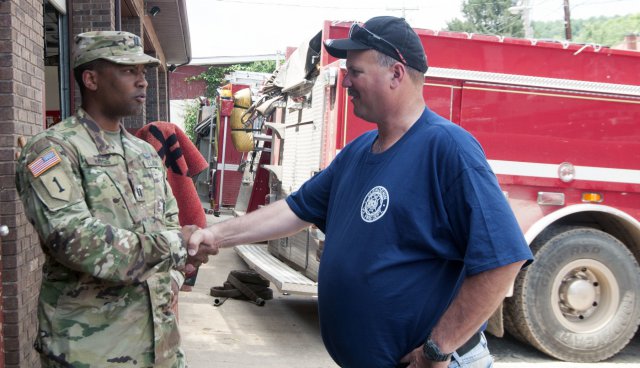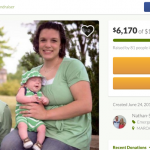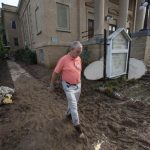By: Sgt. Zoe Morris | Posted: July 1, 2016 | Source: U.S. Army
CLENDENIN, W.Va. – When the flood waters began rising in West Virginia on the night of June 23, the call went out the Clendenin Fire Department’s swift-water rescue unit — one of the best in the state, according to Kevin Clendenin, who is not only fire chief but was also out on a rescue mission that evening.
Within hours, those team members would be working with West Virginia National Guard members on countless rescue missions.
The 12-member team, which also included members of the Glasgow Fire Department, was headed north to Richwood when they got word their hometown was under water. After turning around, they didn’t make it far before the state police got a hold of them about another emergency situation — this time in Birch River, which was near their location.
“We couldn’t pass those folks up,” Clendenin said. “They were chest deep in water and had been there all day.”
The unit pulled over and performed nine rescues in Birch River that evening, knowing their own families were in the same situation an hour south.
When they pulled into the Clendenin area sometime around midnight, Capt. Will Hargis and Soldiers from the CERF-P (Chemical, Biological, Radiological, Nuclear and Explosive Enhanced Response Force Package) team were already there making headway.
The people living through the worst flood in the town’s memory now had a highly trained, joint effort team on their side.
“They had the swift-water rescue teams, and we had the assets to get them in there,” said Hargis. “We were formulating a plan to get their swift-water rescuers and first responders into this area. With the high-water crossing vehicles we have and some of our recognizance assets we have, we were able to get the right people and the right equipment in here to save people’s lives.”
“No doubt they saved lives,” said Clendenin. “No doubt those rescue teams along with CERF-P saved lives in this town.”
Hargis agreed with Clendenin about how the abilities of CERF-P and the firefighters complemented each other.
“I can’t speak enough about having that specialized swift-water rescue team here, available, right at the flash point … having that capability was critical in helping us save lives,” he said.
When Hargis and his troops arrived on the evening of June 23, they were far from going in blind. Hargis already had a Soldier on the ground. Sgt. Chris Legg, B Troop, 1-150th Cavalry/ DECON CERF-P, lives in the Clendenin area where he’s also a town volunteer firefighter. Hargis said Legg was on the ground already helping folks, feeding him information about exactly what was going on and exactly what was needed, even while he was moving people on johnboats and getting them to higher ground.
It turned out the most critical mission was getting a land path into the town, Clendenin said. Working with CERF-P made that possible.
“The communication between Capt. Hargis and I was excellent from the first word,” said Clendenin. “I knew what he was here to do and he knew what I was here to do. It was a joint mission. He said, ‘Whatever you need, chief, we’ll do it.'”

Capt. Will Hargis of the West Virginia Army National Guard’s CERF-P team and Kevin Clendenin, fire chief for the town of Clendenin, W. Va., discuss the details of WVARNG and other first responders’ efforts in saving lives the night of June 23. Sudden, severe flooding threatened the lives of people in the area of Clendenin. The WVARNG worked hand-in-hand with other civilian first responders to quickly react and save lives. Photo Credit: Sgt. Sara Yoke
Because the swift-water rescue team had been out and was coming from the north, they were on one side of the river and their home base crew was on the other.
“Right at daylight I got with Capt. Hargis and said we need a road established in the back side of Clendenin,” Clendenin said. It was a critical mission because if they could get a land route open they could start pushing in rescue teams. They put CERF-P troops with a firefighter and sent them to find a way.
A normal 30-minute drive took just under two hours. The team had to hike the last mile in, over washed-out roads and downed trees, doing “whatever it took.” At just under the two-hour mark they called in and said they made contact with a crew on the other side and had a route to start sending crews in.
Clendenin said some of the rescue teams on the far side had already been at work, but at that point were stranded with some civilians on the second floor of a home. Those rescue crews elected to stay with the civilians until the boats arrived, ensuring safety of every last one.
“To just hunker down and survive may not sound like much, but to me that’s heroic,” said Clendenin.
Surviving was tough in those first 36 hours in Clendenin.
Six people did lose their lives, though not in any location where either the firefighters or CERF-P were operating. It was a large area, the unexpected flooding happened fast and rescue operations were hampered by darkness.
Clendenin said communications were awful, with cell and radio towers down. His firefighters, who are trained not to separate, stayed as a unit, but they were separated that night.
“So you just got to think these guys and gals are trained and they know what to do and hopefully they can self survive,” he said.
When dawn broke Friday morning and the land route was established, the rescue teams started moving people out, many to Charleston. More than 60 people were rescued from critical situations by the evening of June 24, Hargis said.
“You can’t put into words what it is to know you had some impact to saving some folks’ lives,” he said. “Obviously these folks are devastated as far as their homes, their businesses, but at the end of the day, if we’re saving people’s lives, that’s something we can take away from this.”
Hargis, a Cavalry officer, serves an additional duty as officer-in-charge of the WVNG’s CERF-P located in Eleanor. They are extraction experts, trained for extreme situations including CBRN search and rescue, mass decontamination, medical treatment and triage and fatality search and recovery
“The West Virginia National Guard is always looking for highly motivated people who want to serve their state and local community,” he said. “If you want to be part of your community, help your community, we’ve got the organization right here in West Virginia. You’re going to be able to serve your local community and state, and when the president calls, we have a federal mission. It’s always a great feeling and we’re always looking for great, motivated people.”
As of July 5, the troops were still helping their fellow residents: 619 were on duty, according to figures from the National Guard Bureau.








